At pretty much any point in my life prior to living on this farm, my thought process around learning and/or doing new things went something like this: Oh, a new thing? I’m going to kick ass at this.
On the farm, however, when I take on a new challenge like chickens or bees or starting a small orchard, my thought process is more around the lines of: Oh, I have no idea what I’m doing and I just hope I can muddle through the first year or two without everything dying so I have a chance to get better at this.
Yeah. No pressure.
The good news– in the case of my Little Orchard That Could, at least– is that we’re getting toward the end of the second summer for half of the trees, and nothing has died yet.
I started the orchard with 9 trees last year– two pear trees, two peach trees, and five apple trees.
Some of my awesome friends helped me plant them around the end of May (2015), and we had a really wet spring/summer last year so I didn’t need even to water them. I also decided not to spray them because organic fruit is good, right?
Yeah. By the end of summer I was lucky if any of those trees had more than a handful of leaves that hadn’t been eaten by bugs or dropped off from disease, and I wasn’t sure if the trees would even make it through winter.
I talked to the tree experts at two local nurseries and they basically told me that fruit trees are the most susceptible trees to bugs and disease, and really the only way to keep them alive (particularly while they’re being established) is to spray them with an all-inclusive fruit-tree spray. This type of spray comes with very strict guidelines around use (it’s anti-fungal, insecticidal, etc.), you can only spray it twice a year and not within 2 weeks of harvesting, but the most difficult thing for me was that it can be harmful to bees if sprayed directly on them or where any over-spray can hit the hives.
I went through a whole “well if it’s going to hurt the bees, I guess the trees are all just going to die” phase, but eventually I realized I was being a little dramatic. This isn’t a commercial operation where I’m atomizing a bunch of spray and letting it waft around my property indiscriminately… I use a 2 gallon hand sprayer, there’s virtually no over-spray and of course I would never actually spray any of my bees with it. But even though I felt like I could spray responsibly, I decided to wait it out and see how the trees fared in their second year.
Pretty early I noticed something was wrong with one of my peach trees. It was in bad shape with a fungus called Peach Leaf Curl…
I let the trees bloom (when the bees love them) and start to fruit without interfering, but by early June the leaves and small fruit was under attack by bugs…
So I finally decided that if I wanted the trees to live and produce fruit I needed to spray. Responsibly. I only do this twice a year, on days where there’s no wind, no bees in sight, and nowhere close to my hives.
Last years trees got sprayed in early June… and then for a second time just a week ago.
The difference between the way these trees looked last year and this year is remarkable. They still have leaves, first of all… and that tree with the Peach Leaf Curl? All the leaves look great.
Unfortunately those spots you see on the peaches (called “Peach Scab”) are from a different kind of fungus and because I didn’t apply a fungicide last year or before the fruit developed this year, there’s not much I can do for this harvest. However treating the trees with fungicide this year should help prevent this next year.
This isn’t affecting all the peaches, just some of them, so hopefully I’ll get to taste a bit of fruit from these trees this year.
However, on the good-news front I have a handful of apples and pears growing now, none of which have worms in them.
So that’s nice.
Also– and this is a clear indication of how far behind I am on updating this website– back in May my mom bought me a few more fruit trees to round out the garden…
You probably don’t need more reasons to love my mom (because she’s awesome,obv) but this was a fantastic birthday present, and she also helped me plant all of the new trees…
Plus this “birthday tree” she got me to replace some of the dead pines up front by the bees that I had cleared out last year…
Like I said, that was back in early June, and most of those trees have been doing well since then, except this one that I mentioned in an earlier post.
It turns out that when you do something the works from the very beginning– without failures– you may not realize it’s actually working. The little circles of 5′ pasture fence I put around my fruit trees are a great example of this…
I put these on almost immediately when I planted my trees last year, and nothing really disturbed my trees, so I really wasn’t sure if they were effective or not (and because literally no one has recommended this approach to keeping deer away from your fruit trees–and it’s a hell of a lot easier than putting in a deer fence–I figured this probably wasn’t doing anything.)
Then, I planted 2 cherry trees, 1 more peach tree, and 3 more apple trees, and I wasn’t super motivated to put the little fences around them… less than a week later half of the leaves were eaten off one of the peach and cherry trees, and, well, you saw what happened to that little twig that used to be a bing cherry above…
So you can bet your ass I got all the new trees covered ASAP. I also spent a fair amount of time in late spring and early summer with my tractor and a 60 gallon tank watering both the new trees and my new grape vines…
I also got a lesson in how to properly prune everything from my grandmother…
And wouldn’t you know it, a month later, look at that little cherry…
Other than that cherry tree, all the new trees managed fairly well for the first two months, and– because they hadn’t ever been sprayed– by August they were looking pretty bad. So they all got a dose of the fruit tree spray last week as well.
That’s the last time any of these trees will be sprayed this year, and I’ll collect (and wash before eating) a fair amount of peaches, some pears, and a handful of apples if all goes well for the next month or two.
The orchard currently has 15 trees (2 pear, 2 cherry, 3 peach, and 8 apple) and while I’d like to add a few more pear and cherry trees, I’ve made a commitment to wait until spring 2018 before adding any more (since I clearly have my hands full these days already.)
As it turns out, having a healthy orchard is a bit more work than sticking some trees in the ground and just sitting around waiting until they bear fruit, and while the pests and disease can be discouraging, I’m embracing the opportunity to learn to be a good caretaker of my little orchard.




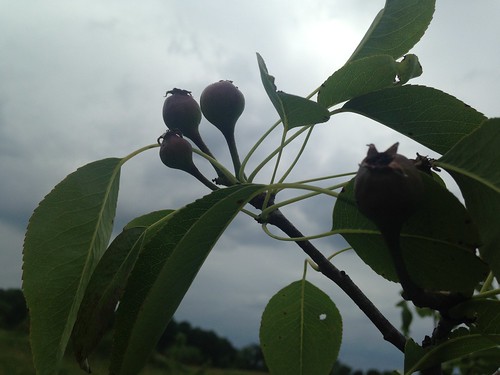
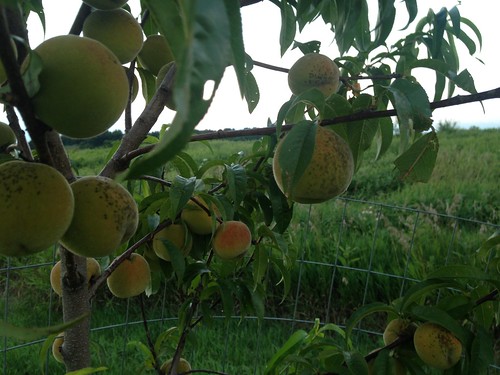
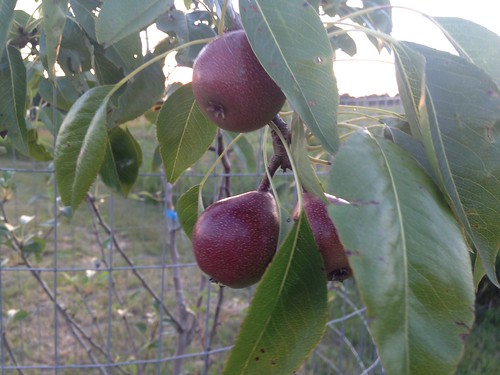



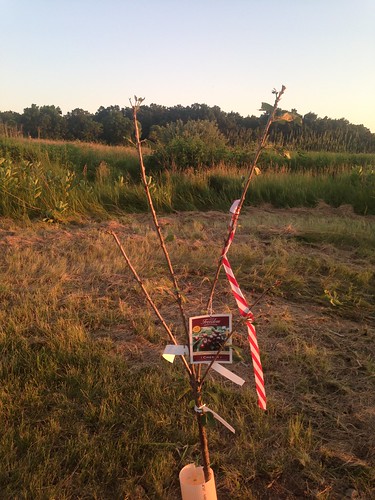
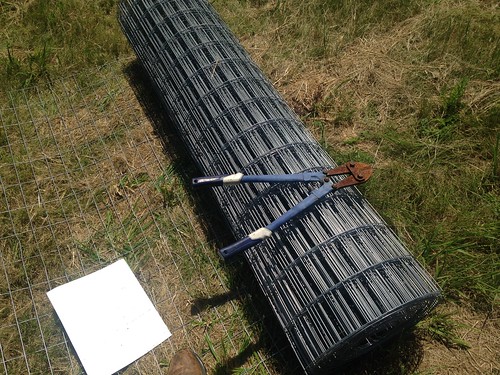

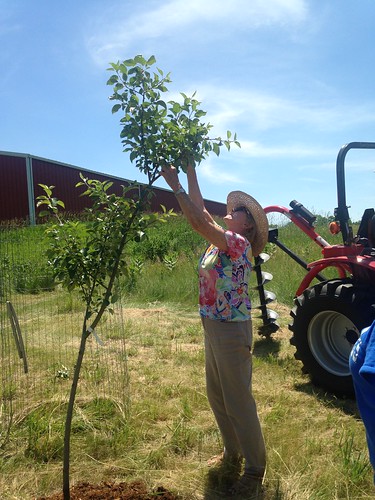
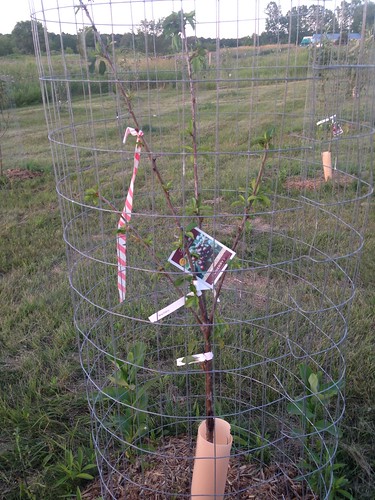

22 Responses
Thrilled for you…excellent decisions…you’re doing great!
You have some awesome ladies backing you 🙂 Awesome.
Once my fruit trees got taller, I put a smaller sprayer thing in a fruit picker for upper branches. So much easier than ladders. Hopefully you’ll need this advice!
Perhaps in the coming years your guinea hens will take over the pest control? I hope mine will 🙂
The spray will not affect the bees after it dries while they are foraging on the flowers?
Glad to see you are pruning to shape branch growth, buddy of mine did not and has boards propping up branches on a 6 year old heavily fruiting peach tree. SMH.
You could probably go with a bigger diameter cages with 2-3 tposts….or the deer may push them right over.
I was wondering about the dried stuff affecting the bees too?
I have a several year old apricot tree that I have growing with no disease pest treatment. That is not working. So I have to figure out what to do. One would think arborists would know what is wrong with a fruit tree so one could use a targeted approach. One would be wrong. Even the local ag extension was of zero use.
There is something entertaining about following along with a DIY gardener that has a number of challenging projects and a slightly foul mouth!
All of the images are broken for me. Is it just me? 🙂
Working now…false alarm 🙂
Always good to get an update from you Kit. You may be interested in permaculture which focuses around companion planting. (Maybe you already know about this). My friend uses this method so she doesn’t have to spray as much. I don’t know much about it but I do know that nasturtiums and peach trees are ‘companions.’
Not sure if this would work for you and your orchard, but my local organic farm uses kaolin clay on their peaches to keep pests away. They seem to think it works quite well.
Magic Eight Ball sees drip irrigation in your future.
I only water the newly planted trees, so hopefully I won’t need it in another year… the orchard and barn are a long way away from any water source so I’d have to be willing to spend a few thousand dollars on a very long trench or a new well (love the plants but I’m not willing to go that far!) 😉
I just put in 3 apple trees and an almond tree this summer and when I went this morning to check on them I found two beetles having sex on my sun crisp tree! I was so offended!! Haha. Time to look in to sprays… I have no idea what I’m doing but I want me some apples in 2-3 years. 🙂
I volunteer as an extension MG and we spend a lot of time w/ clients that grow fruit for fun &/or profit. We provide them w/ the info necessary to help them determine if growing fruit is worth the time, $ and effort necessary to be successful in our area. Many are very successful and enjoy it and many give up because it’s not as they envisioned.
For those of you thinking about planting, or already growing fruit trees – please contact your state’s land grant university for their specific pubs on growing this type of tree. (I’m in Virginia, so my uni is VaTech.) Not all county extension agents have extensive knowledge in all areas of horticulture – but the expert info is out there online at sites that end in (dot)edu, or (dot)org.
Fruit trees can have very narrow time period windows for effective spraying. Any spraying before or beyond these windows is wasted spray. Temp is also critical for many chemicals and too hot or too cold renders many of them inert or volatile. Follow all product instructions to the letter to avoid harming yourself or pollinators. And never, ever spray any chemical over your head where unseen mist can settle on you.
PSA over. Good Luck Kit!
Great advice, thanks Nancy! Almost all my information on disease and management has come from local extensions website… there’s a ton of good info out there!
Your fruit looks beautiful. It makes me hungry (of course, it doesn’t take much to make me hungry, but the fruit is still inspiring.)
wow, your orchard is really sprouting! great job! everything in life is a learning curve, and requires perseverance before payoff, but you’re getting there!
What do you use to spray your trees? I’ve planted a handful of trees this year and my first pkg of bees is coming in the next few weeks. I already see some insect damage and haven’t been able to commit to a pesticide for fear of hurting the eventual bees. Help!
I use a general fruit-tree spray (which is NOT good for bees) but I wait until after the fruit trees bloom and the bees aren’t interested in them anymore and in my case the trees aren’t anywhere near my hives so there’s no risk of overspray etc.
Comments are closed.